ASRock Z87 OC Formula/AC Review
by Ian Cutress on July 26, 2013 10:00 AM EST- Posted in
- Motherboards
- ASRock
- Haswell
- Z87
Computation Benchmarks
Readers of our motherboard review section will have noted the trend in modern motherboards to implement a form of MultiCore Enhancement / Acceleration / Turbo (read our report here) on their motherboards. This does several things – better benchmark results at stock settings (not entirely needed if overclocking is an end-user goal), at the expense of heat and temperature, but also gives in essence an automatic overclock which may be against what the user wants. Our testing methodology is ‘out-of-the-box’, with the latest public BIOS installed and XMP enabled, and thus subject to the whims of this feature. It is ultimately up to the motherboard manufacturer to take this risk – and manufacturers taking risks in the setup is something they do on every product (think C-state settings, USB priority, DPC Latency / monitoring priority, memory subtimings at JEDEC). Processor speed change is part of that risk which is clearly visible, and ultimately if no overclocking is planned, some motherboards will affect how fast that shiny new processor goes and can be an important factor in the purchase.
As mentioned in the BIOS, the ASRock Z87 OC Formula/AC supports MultiCore Acceleration by default on the 1.42B BIOS and above (thus 1.50 for public).
Point Calculations - 3D Movement Algorithm Test
The algorithms in 3DPM employ both uniform random number generation or normal distribution random number generation, and vary in various amounts of trigonometric operations, conditional statements, generation and rejection, fused operations, etc. The benchmark runs through six algorithms for a specified number of particles and steps, and calculates the speed of each algorithm, then sums them all for a final score. This is an example of a real world situation that a computational scientist may find themselves in, rather than a pure synthetic benchmark. The benchmark is also parallel between particles simulated, and we test the single thread performance as well as the multi-threaded performance.
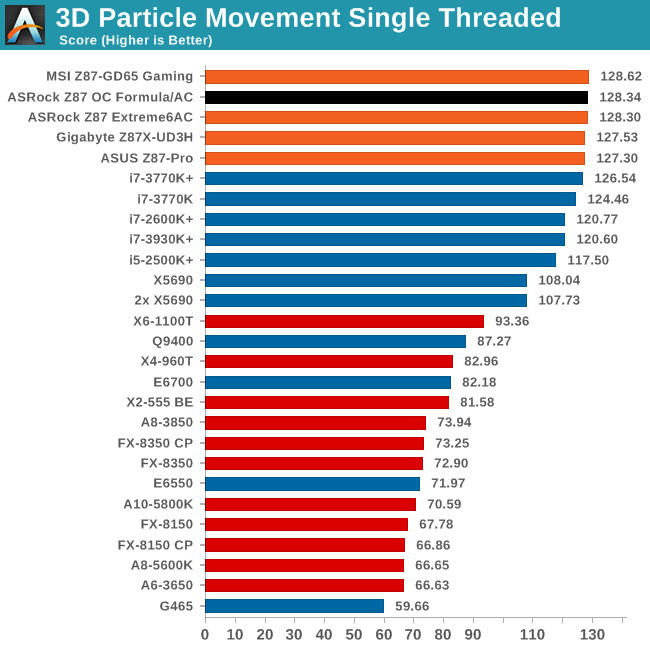
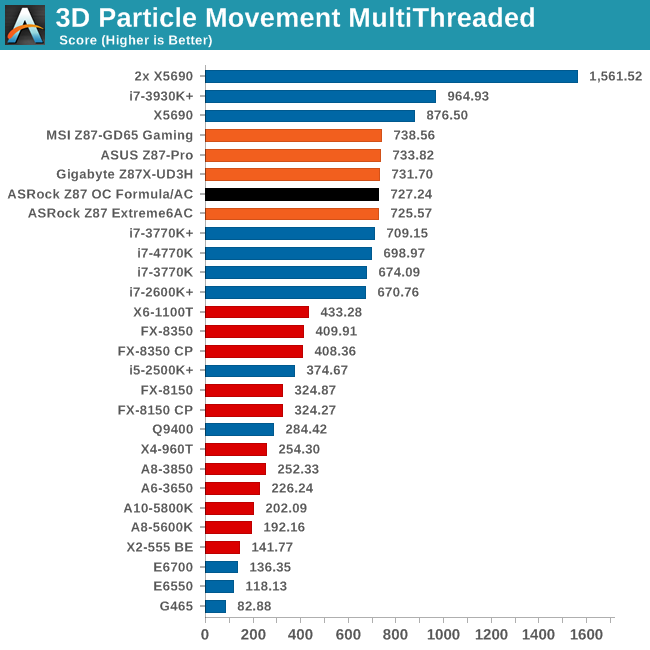
At stock, the OC Formula performs similarly to the Extreme6 – a paper width in single thread but not the most efficient in multi-thread.
Compression - WinRAR 4.2
With 64-bit WinRAR, we compress the set of files used in the USB speed tests. WinRAR x64 3.93 attempts to use multithreading when possible, and provides as a good test for when a system has variable threaded load. WinRAR 4.2 does this a lot better! If a system has multiple speeds to invoke at different loading, the switching between those speeds will determine how well the system will do.
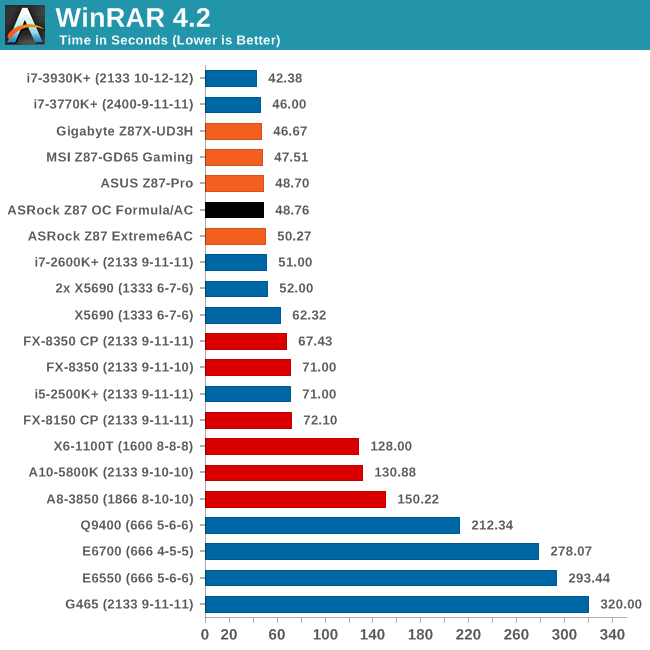
The ASRock’s performance in WinRAR is better than the Extreme6, but is still behind the Gigabyte which leads the way as the most efficient.
Image Manipulation - FastStone Image Viewer 4.2
FastStone Image Viewer is a free piece of software I have been using for quite a few years now. It allows quick viewing of flat images, as well as resizing, changing color depth, adding simple text or simple filters. It also has a bulk image conversion tool, which we use here. The software currently operates only in single-thread mode, which should change in later versions of the software. For this test, we convert a series of 170 files, of various resolutions, dimensions and types (of a total size of 163MB), all to the .gif format of 640x480 dimensions.
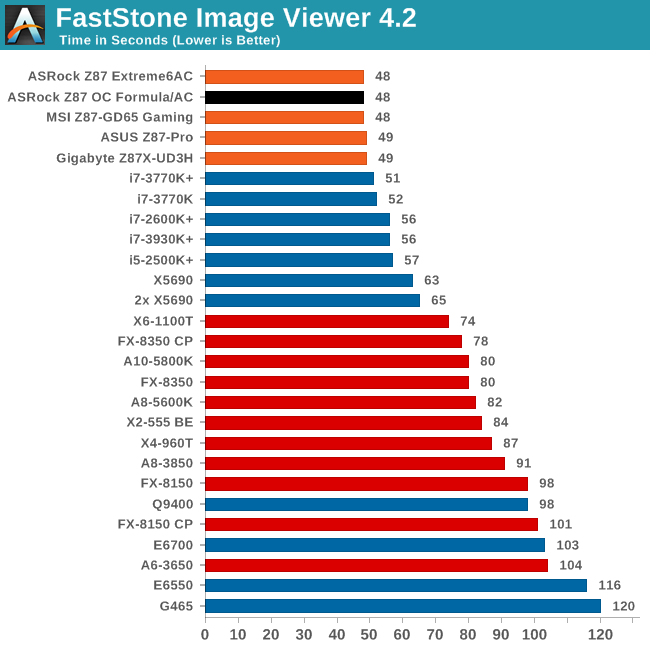
Video Conversion - Xilisoft Video Converter 7
With XVC, users can convert any type of normal video to any compatible format for smartphones, tablets and other devices. By default, it uses all available threads on the system, and in the presence of appropriate graphics cards, can utilize CUDA for NVIDIA GPUs as well as AMD WinAPP for AMD GPUs. For this test, we use a set of 33 HD videos, each lasting 30 seconds, and convert them from 1080p to an iPod H.264 video format using just the CPU. The time taken to convert these videos gives us our result.
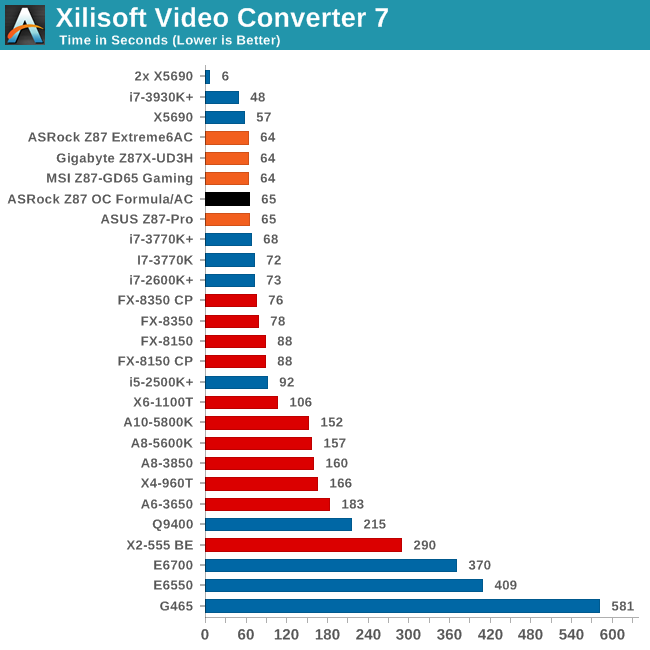
Not much between all motherboards for video conversion.
Rendering – PovRay 3.7
The Persistence of Vision RayTracer, or PovRay, is a freeware package for as the name suggests, ray tracing. It is a pure renderer, rather than modeling software, but the latest beta version contains a handy benchmark for stressing all processing threads on a platform. We have been using this test in motherboard reviews to test memory stability at various CPU speeds to good effect – if it passes the test, the IMC in the CPU is stable for a given CPU speed. As a CPU test, it runs for approximately 2-3 minutes on high end platforms.
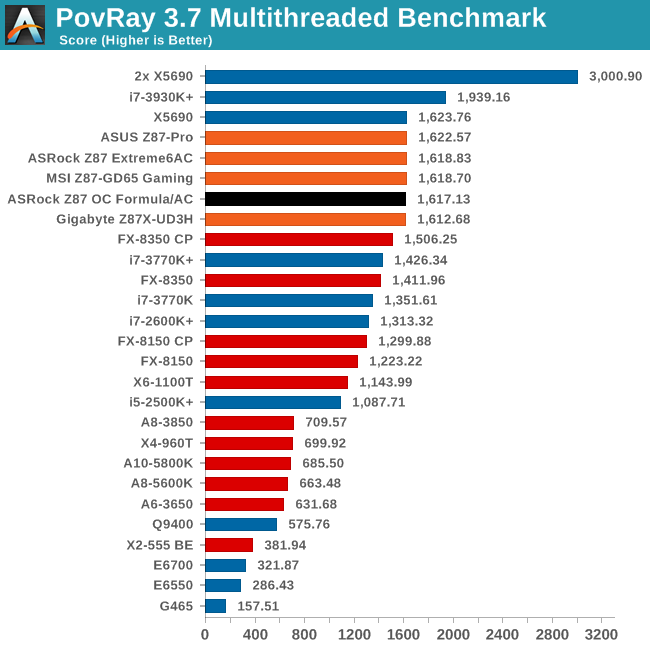
Video Conversion - x264 HD Benchmark
The x264 HD Benchmark uses a common HD encoding tool to process an HD MPEG2 source at 1280x720 at 3963 Kbps. This test represents a standardized result which can be compared across other reviews, and is dependent on both CPU power and memory speed. The benchmark performs a 2-pass encode, and the results shown are the average of each pass performed four times.
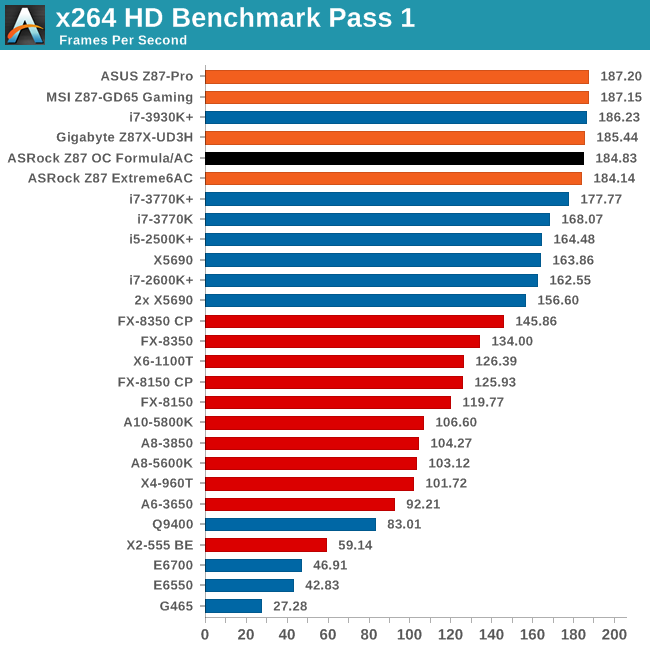
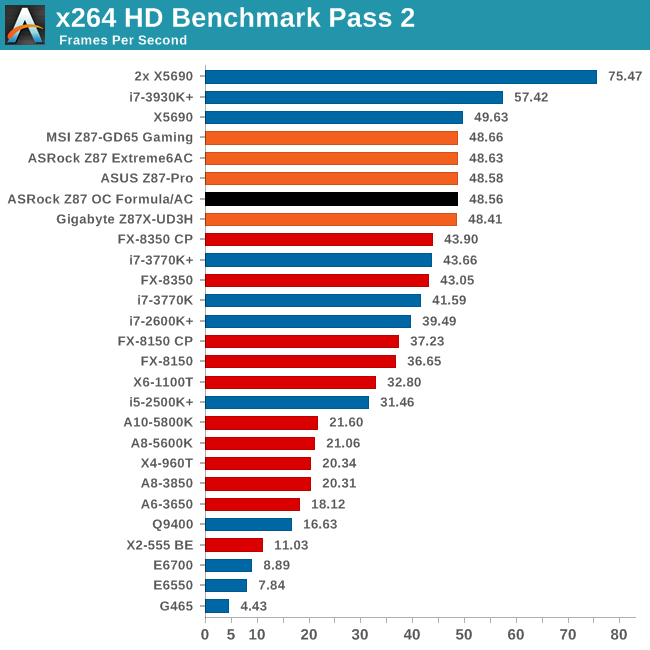
Grid Solvers - Explicit Finite Difference
For any grid of regular nodes, the simplest way to calculate the next time step is to use the values of those around it. This makes for easy mathematics and parallel simulation, as each node calculated is only dependent on the previous time step, not the nodes around it on the current calculated time step. By choosing a regular grid, we reduce the levels of memory access required for irregular grids. We test both 2D and 3D explicit finite difference simulations with 2n nodes in each dimension, using OpenMP as the threading operator in single precision. The grid is isotropic and the boundary conditions are sinks. Values are floating point, with memory cache sizes and speeds playing a part in the overall score.
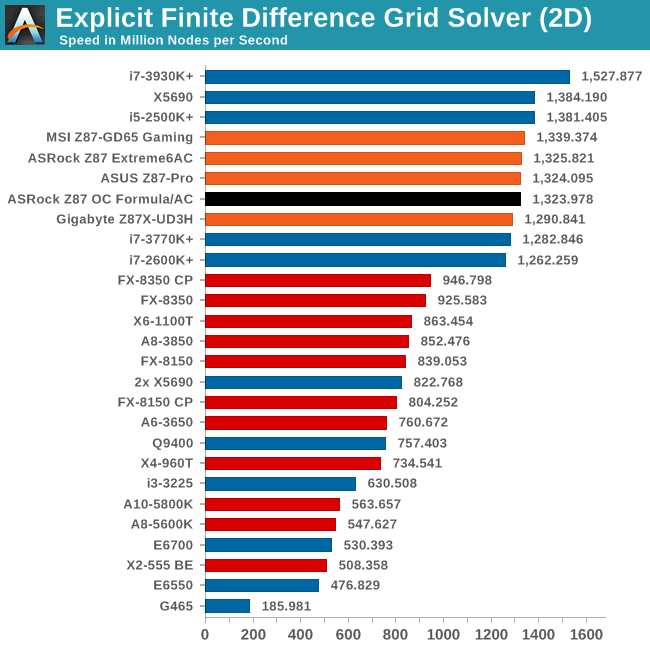
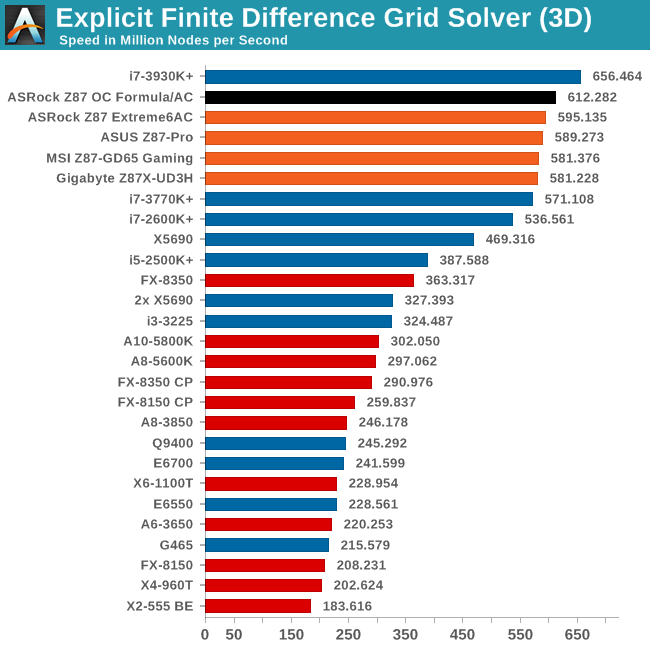
The OC Formula takes a nice lead in the Explicit Finite Difference (3D) test. This test is highly sensitive to memory subtimings, so although we are at XMP, ASRock may have done something useful here in the BIOS.
Grid Solvers - Implicit Finite Difference + Alternating Direction Implicit Method
The implicit method takes a different approach to the explicit method – instead of considering one unknown in the new time step to be calculated from known elements in the previous time step, we consider that an old point can influence several new points by way of simultaneous equations. This adds to the complexity of the simulation – the grid of nodes is solved as a series of rows and columns rather than points, reducing the parallel nature of the simulation by a dimension and drastically increasing the memory requirements of each thread. The upside, as noted above, is the less stringent stability rules related to time steps and grid spacing. For this we simulate a 2D grid of 2n nodes in each dimension, using OpenMP in single precision. Again our grid is isotropic with the boundaries acting as sinks. Values are floating point, with memory cache sizes and speeds playing a part in the overall score.
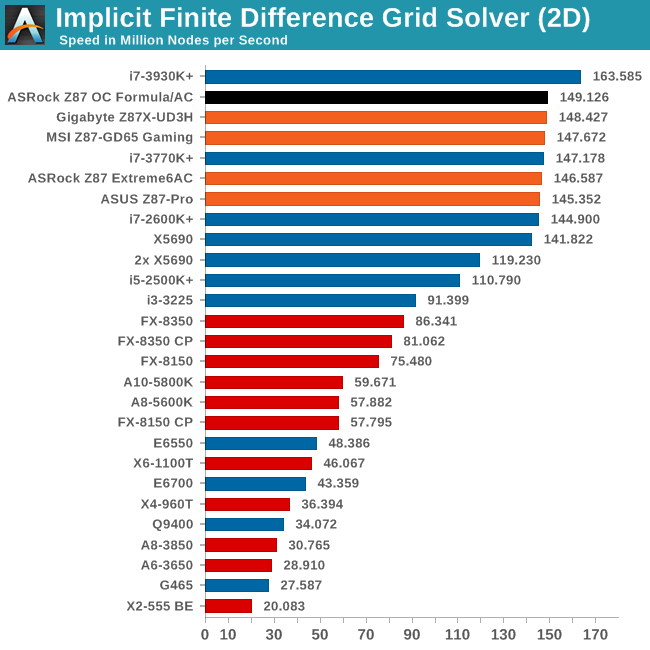
While only a small lead, a similar situation to Ex3D happens in Im2D which also has a lot of memory accesses involved.
Point Calculations - n-Body Simulation
When a series of heavy mass elements are in space, they interact with each other through the force of gravity. Thus when a star cluster forms, the interaction of every large mass with every other large mass defines the speed at which these elements approach each other. When dealing with millions and billions of stars on such a large scale, the movement of each of these stars can be simulated through the physical theorems that describe the interactions. The benchmark detects whether the processor is SSE2 or SSE4 capable, and implements the relative code. We run a simulation of 10240 particles of equal mass - the output for this code is in terms of GFLOPs, and the result recorded was the peak GFLOPs value.
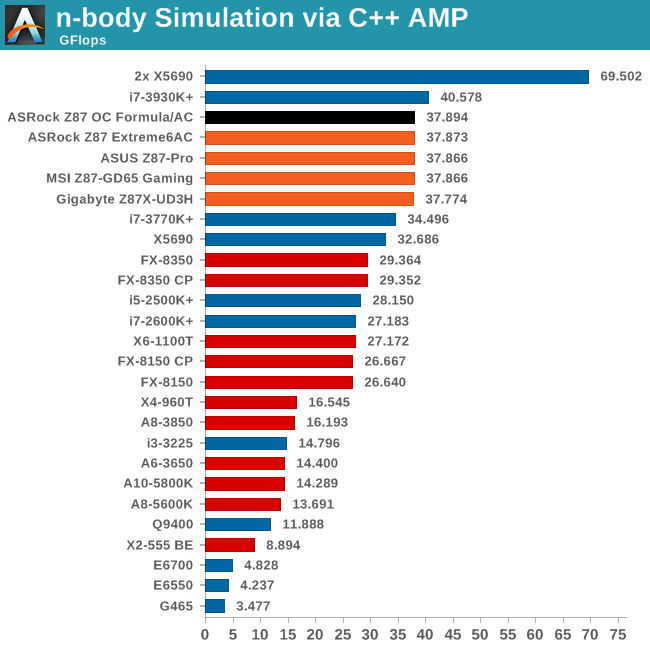










22 Comments
View All Comments
Sabresiberian - Friday, July 26, 2013 - link
I like the idea of a conformal coating, but ASRock needs to have done its homework thoroughly. Such a coating can actually cause components to fail because the rise and fall of temperatures flexes the component parts and solder joints as the coating literally pulls the components down when the system gets colder. This can happen at relatively normal temperature ranges, bringing board components down to temps they might see with a little spilled LN2 makes it even more critical. That being said, it is probably less of an issue now than it was 30 years ago when I was involved in the testing of conformal coatings on circuit boards. :)I wouldn't let it stop me from buying the board, as I say I like the idea, but it would be in the back of my mind if I did. It IS a great idea to protect the mainboard from the effects of condensation or a leak in a water cooling system. A +1 in my book for ASRock.
GuardianAngel470 - Saturday, July 27, 2013 - link
It seems to have been a while since you last looked at conformal coatings. The ONLY artificial coating I know of described as Superhydrophobic is Neverwet, a recent advancement in nanotechnology.It can be applied to clothing, fabrics, metals, plastics, and a heck of a lot else without the need for restrictive layers like previous coatings. It's more like a paint than a coating.
owan - Monday, July 29, 2013 - link
There are lots of treatments that can be described as "superhydrophobic" other than Neverwet, which is just a brand name. It could be one of several different nano-structures, silicones, or fluorochemicals. Extremely hydrophobic materials are not newzero2dash - Friday, July 26, 2013 - link
Dat LCD....that is some neat stuff. I hope to see Gigabyte do something similar in the future.buzznut - Tuesday, July 30, 2013 - link
I have to agree, I've only bought two motherboards over $200, one was an ASUS Crosshair 1 that never worked right and the Asrock Z77 OC formula which is in RMA right now. Both of which tech support is almost non-existent.I will certainly think twice before ordering another mobo over $200. I am an enthusiast and modder, but it just doesn't make sense to spend that much money when I've had $100 motherboards that are still in service after 5 years.
Hrel - Friday, July 26, 2013 - link
Lol $330. If you spend over 200 on a motherboard you're an idiot.If you spend over 150 you don't care about value.
Competitive overclockers excluded from "idiot" category. It's ok to be frivolous on a hobby.
Slash3 - Saturday, July 27, 2013 - link
So, what you're saying is that it's priced just fine for the features it delivers?tech6 - Monday, July 29, 2013 - link
+1So called enthusiast boards are mostly a waste of money. There are few commonly run apps that significantly benefit from CPU or memory overclocking. For that sort of money you'd be better off with a second graphics card or an SSD.
iTzSnypah - Friday, July 26, 2013 - link
Please please learn to overclock Haswell. You are killing the potential of these reviews with novice overclocking.When an automatic overclock uses the same CPU voltage as your manual overclock to reach 4.6Ghz you know you are doing something wrong.
Razorbak86 - Saturday, July 27, 2013 - link
"As a competitive overclocker myself, I find this hobby of mine absolutely fascinating. I have had some mild success personally, hitting near the top of the enthusiast league for several years, achieving success in local competitions and I currently hold a number of UK records. I joined HWBot before I really got into enthusiast hardware, and through HWBot I joined the local UK team and luckily I had a chance encounter at a Gigabyte overclocking event with an AnandTech editor which started my writing career." - Ian Cutresshttp://www.anandtech.com/show/7081/competitive-ove...
Just out of curiosity, how many overclocking records do you hold?